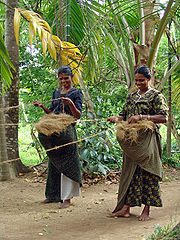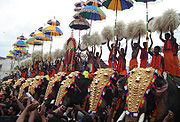Since independence, Kerala was managed as a democratic socialist welfare economy. Since the 1990s, liberalisation of the mixed economy allowed onerous Licence Raj restrictions against the free market and foreign direct investment to be lightened, leading to economic expansion and job creation. In fiscal year 2004–2005, nominal gross state domestic product (GSDP) was Rs 89,451.99 crore (US$ 17.94 billion). Recent GSDP growth (9.2% in 2004–2005 and 7.4% in 2003–2004) has been robust compared to historical averages (2.3% annually in the 1980s and between 5.1% and 5.99% in the 1990s). The state clocked 8.93% growth in enterprises from 1998 to 2005 compared with 4.80% nationally. Relatively few such enterprises are major corporations or manufacturers. Per-capita GSDP is Rs. 11,819 (US$ 237.09), above the Indian average and far below the world average. Kerala's Human Development Index rating is the highest in India. This apparently paradoxical "Kerala phenomenon" or "Kerala model of development" of high human and low economic development results from the strong service sector. Kerala's economy depends on emigrants working in foreign countries (mainly in the Gulf countries such as Dubai or Bahrain) and remittances annually contribute more than a fifth of GSDP.
 The service sector (including tourism, public administration, banking and finance, transportation, and communications—63.8% of GSDP in 2002–2003) and the agricultural and fishing industries (together 17.2% of GSDP) dominate the economy. Nearly half of Kerala's people are dependent on agriculture alone for income. Some 600 varieties of rice (Kerala's most important staple food and cereal crop) are harvested from 3105.21 km2 (a decline from 5883.4 km2 in 1990) of paddy fields; 688,859 tonnes are produced per annum. Other key crops include coconut (899,198 ha), tea, coffee (23% of Indian production, or 57,000 tonnes, rubber, cashews, and spices—including pepper, cardamom, vanilla, cinnamon, and nutmeg. Around 1.050 million fishermen haul an annual catch of 668,000 tonnes (1999–2000 estimate); 222 fishing villages are strung along the 590 km coast. Another 113 fishing villages dot the hinterland. The service sector (including tourism, public administration, banking and finance, transportation, and communications—63.8% of GSDP in 2002–2003) and the agricultural and fishing industries (together 17.2% of GSDP) dominate the economy. Nearly half of Kerala's people are dependent on agriculture alone for income. Some 600 varieties of rice (Kerala's most important staple food and cereal crop) are harvested from 3105.21 km2 (a decline from 5883.4 km2 in 1990) of paddy fields; 688,859 tonnes are produced per annum. Other key crops include coconut (899,198 ha), tea, coffee (23% of Indian production, or 57,000 tonnes, rubber, cashews, and spices—including pepper, cardamom, vanilla, cinnamon, and nutmeg. Around 1.050 million fishermen haul an annual catch of 668,000 tonnes (1999–2000 estimate); 222 fishing villages are strung along the 590 km coast. Another 113 fishing villages dot the hinterland.
Traditional industries manufacturing such items as coir, handlooms, and handicrafts employ around one million people. Around 180,000 small-scale industries employ around 909,859 Keralites; 511 medium and large scale manufacturing firms are located in Kerala. A small mining sector (0.3% of GSDP) involves extraction of ilmenite, kaolin, bauxite, silica, quartz, rutile, zircon, and sillimanite. Home gardens and animal husbandry also provide work for hundreds of thousands of people. Other major sectors are tourism, manufacturing, and business process outsourcing. As of March 2002, Kerala's banking sector comprised 3341 local branches; each branch served 10,000 persons, lower than the national average of 16,000; the state has the third-highest bank penetration among Indian states. Unemployment in 2007 was estimated at 9.4%; underemployment, low employability of youths, and a 13.5% female participation rate are chronic issues. Poverty rate figures range from 12.71% to as high as 36%. More than 45,000 residents live in slum conditions.
|
 The service sector (including tourism, public administration, banking and finance, transportation, and communications—63.8% of GSDP in 2002–2003) and the agricultural and fishing industries (together 17.2% of GSDP) dominate the economy. Nearly half of Kerala's people are dependent on agriculture alone for income. Some 600 varieties of rice (Kerala's most important staple food and cereal crop) are harvested from 3105.21 km2 (a decline from 5883.4 km2 in 1990) of paddy fields; 688,859 tonnes are produced per annum. Other key crops include coconut (899,198 ha), tea, coffee (23% of Indian production, or 57,000 tonnes, rubber, cashews, and spices—including pepper, cardamom, vanilla, cinnamon, and nutmeg. Around 1.050 million fishermen haul an annual catch of 668,000 tonnes (1999–2000 estimate); 222 fishing villages are strung along the 590 km coast. Another 113 fishing villages dot the hinterland.
The service sector (including tourism, public administration, banking and finance, transportation, and communications—63.8% of GSDP in 2002–2003) and the agricultural and fishing industries (together 17.2% of GSDP) dominate the economy. Nearly half of Kerala's people are dependent on agriculture alone for income. Some 600 varieties of rice (Kerala's most important staple food and cereal crop) are harvested from 3105.21 km2 (a decline from 5883.4 km2 in 1990) of paddy fields; 688,859 tonnes are produced per annum. Other key crops include coconut (899,198 ha), tea, coffee (23% of Indian production, or 57,000 tonnes, rubber, cashews, and spices—including pepper, cardamom, vanilla, cinnamon, and nutmeg. Around 1.050 million fishermen haul an annual catch of 668,000 tonnes (1999–2000 estimate); 222 fishing villages are strung along the 590 km coast. Another 113 fishing villages dot the hinterland.

